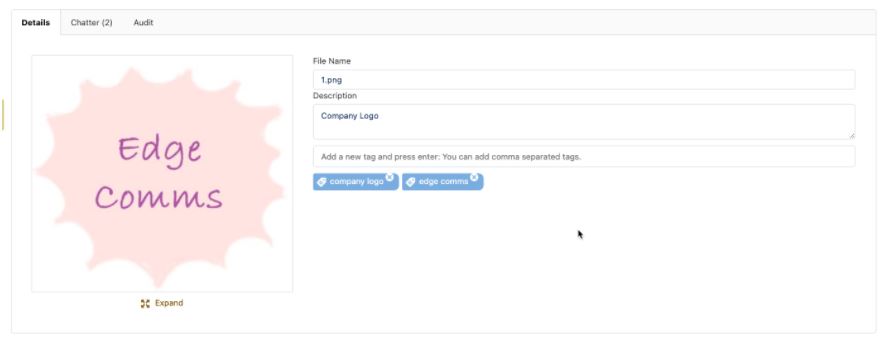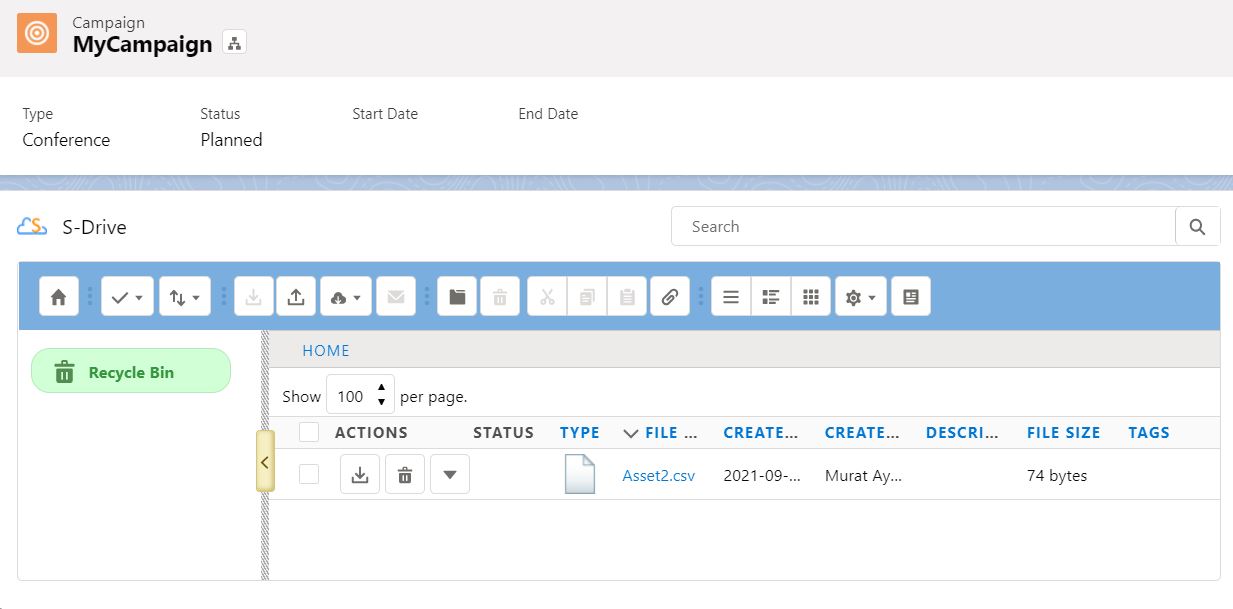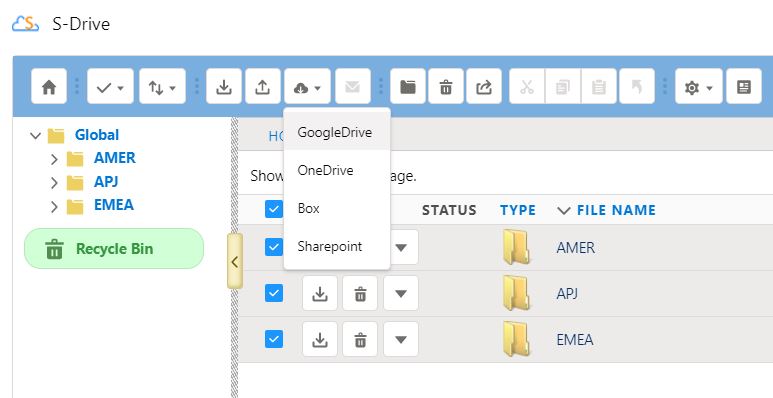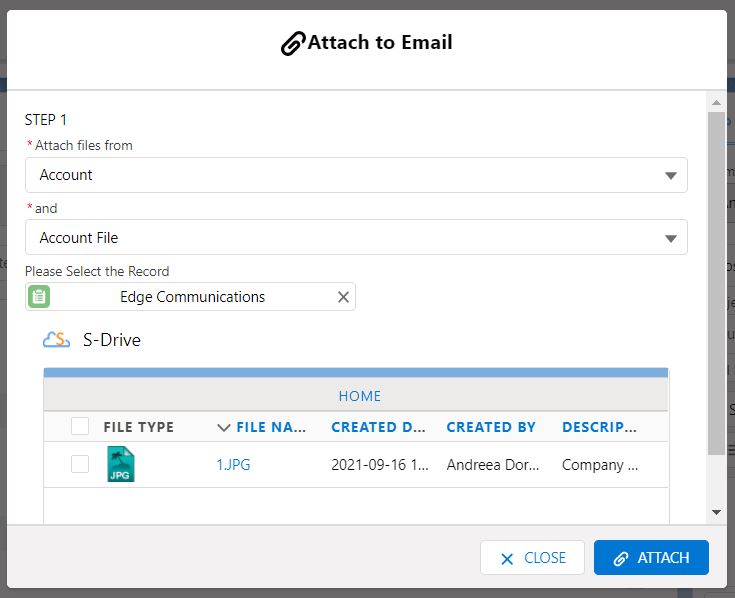Wouldn’t it be nice to manage all of your digital assets directly within your Salesforce instance, without having to worry about reaching the storage limit? As the only native Salesforce file storage and distribution application available today, S-Drive ensures your content is neatly organized, secure, and always within easy reach!
Highlights
- Unlimited storage space on Amazon S3.
- User-friendly alternative to FTP (File Transfer Protocol).
- Custom retention policies for any type of file (.pdf,.pptx, etc.).
Storing documents in Salesforce is an unavoidable truth. Admins would like all data to be standardized and stored within Salesforce fields. However, there will always be invoices or sales presentations that users will need to access from Salesforce records. While using Salesforce Files is an option, exceeding the 10GB allowed per org could prove to be a really expensive surprise cost.
S-Drive successfully combines the multiple Salesforce capabilities with Amazon’s secure file storage. The result is unlimited space for your team to upload, download, and share files – all within a CRM they’re already accustomed to. This in-depth review will dive into S-Drive’s features, ideal use cases, and setup effort, as well as the ways this app, will transform document management on the Salesforce platform.
Features
The S-Drive team is committed to offering a user-friendly experience while keeping files secure and accessible.
We will zoom into the main features this app has to offer in the Lightning Experience, all of which are available in Salesforce Classic – if there are still users in your org yet to make the move to Lightning!
S-Drive App
The S-Drive App is the place where it all starts; here, you will connect Salesforce orgs (be it in a sandbox or production environment).
Also, the billing information and usage metrics will always be on hand to help keep an eye on the cost.


Once the managed package is installed in the connected Salesforce environments, the S-Drive Lightning App also becomes available. While content and functionalities can be managed and accessed from here, any included Lightning Web Components (such as Email which we’ll explore later in the review) can be added on record pages for simplified access.
Connect to Google Drive, OneDrive, Box, Sharepoint
Manually dropping local files from one folder to another is and will always be a possibility. However, the reality, nowadays, is that all companies have at least one way to store their documents in a shared drive online.
Since this is achievable through Salesforce Files Connect, the initial configuration is required. Here, the payoff is immediate access to streamlined data.
Folder Hierarchy
Folders are the first layer, to begin with when building the way assets will be organized. As it’s likely that there won’t be just one folder created, a description is a recommended field to complete – this will provide context and avoid users having to dig around in the folder’s content.
After deciding on a folder structure that makes sense for your organization (arranged by department, geography, or any other criteria), folders can be nested and the hierarchy can become as complex as you need it to be.
When creating folders, you can also opt to either inherit the sharing rules from their parent folder, or not.
Regardless of the choice, the folder can be shared separately as needed (Read-only or Read/Write), with the possibility of cascading the access to sub-files and folders.
Creating folders one by one is a feasible option when you start from scratch. If you already have some folders stored on another platform, you can choose to import them directly in S-Drive once you have gone through the configuration.
As an additional bonus, all users are surely familiar with the concept of a folder – this will make adoption really easy from the get go!
Files
Uploading the files is even more simple than setting up the folders – files can be either dragged and dropped or manually added using the “+ Add” button. Once displayed, you can add a description (or choose to require more fields upon upload) and then proceed with the actual upload for all of them at once.
Progress will be shown at the bottom. Files can inherit the sharing access from their parent folder or they can be shared separately – this is useful if specific files should be hidden from users with access to the folder.
For both successful and failed operations, a pop-up will show the status. Moreover, if any failure occurs, the operation might be retried automatically. Alternatively, you can hover over the yellow icon next to the file name.
Global Search
Remember how your users are accustomed to searching anything they need using the native global search functionality? Since in the end it’s a Salesforce object the files are stored in, the same thing can be enabled for all your S-Drive files.
Not only can you create a tab for each files object and make it searchable, but you can also add a lightning component onto their Record Pages to both give you a preview and access to the “Open in S-Drive” button.


S-Drive Email
This Lightning Web Component can be added to any object’s record page to streamline sending emails, along with attachments, from S-Drive. For example, multiple recipients can be added at the same time, with no restrictions as far as their company goes.
Also, attachments can be selected from any object with S-Drive files enabled, regardless of their relationship with the current record or recipients.
Additional Settings
Within the configuration tab, there are a lot more things that can be controlled for the experience to be better tailored to your org’s requirements.
On top of being able to set the time the batches which transfer the data are executed, you can opt to transfer files (or not) to records created following the Lead Conversion.


When it comes to making use of S-Drive functionality, you have granular control over the file size and actions available for related files (for either the Standard or Custom Salesforce objects) specifically when it comes to any tracking actions against files as well as reporting and auditing purposes.


Here, you can also tweak the user access and restrict sharing certain categories, as needed.


Use Cases
Sales
When it comes to customer conversations, it is often the case that at least one document is involved – be this a presentation shared during a meeting, or a quick snip shared with the Account Team.
The best place to store these is obviously at the Account level, so they can be easily found in the future. Out-of-the-box, S-Drive supports this process for Accounts, Leads, Contacts, Opportunities, and Cases with the simple addition of the Lightning Component on the Record Page.
Keep in mind that you can always enable the S-Drive functionality on custom objects as well given not all organisations may heavily use standard objects for this purpose.


Uploaded files will be related to the particular Account, with the possibility to edit and even tag the assets if they should be searched for and found by users without accessing the record.


Marketing Content Management
While it is obviously an option to add the files to the Campaign (see below), there is also the option to integrate with Marketing Cloud to avoid further content storage cost.


Both options will not only make it easier for marketers to track initiative related assets, they will also make the process of sharing with collaborators (such as agencies) a lot smoother.
Impact
Streamlined Experience
S-Drive is sure to make working with files hassle-free for any Salesforce user, regardless of their department or skill level. On top of this, being able to clearly define every detail, from the fields displayed or required to the way files are shared internally or externally, makes this tool a fruitful investment.
Money Saver
Perhaps one of the most important aspects, especially for leadership, is the reduced cost in comparison with, for example, Salesforce Files. Considering the ease of use and the number of available functionalities, the return on investment is undeniable.
Compliance
For businesses working with customers in Europe, GDPR is a game changer from a compliance perspective, and can become a hassle when implementing safeguards.
S-Drive, however, provides a fast way to implement policies concerning files with sensitive information. Not only can the downloads be limited and links set to expire, you can also set up criteria to either retain or dispose of certain files.


This is offered by S-Drive as a micro service priced at $500/month. You can enable this from the S-Drive Configuration tab. You can also find out about the other micro services available for free.
Setup
Maybe after reading this far, you would expect the setup to be a hassle – it’s actually the exact opposite! When visiting the S-Drive Configuration tab for the first time, each step towards completing the setup will be highlighted as you progress. An Account should be created for the S-Drive App and your organization connected.


If you’d like to briefly explore the tool, you can connect your production environment or a Salesforce Sandbox.
This is the place where all billing information can be added and accessed (along with your usage by org) as you start using the services after your trial expires. Payments can also be processed by linking your Amazon Account.


Once you have the S-Drive managed package installed in Salesforce and the configuration steps have been finalized, everything is ready for assets to start being uploaded and organized.
You will need to have an Amazon S3 Account already set up before proceeding (Access and Secret Keys are required). The only thing left to do is create a bucket for your folders and files to be stored in. Be sure to check the Amazon bucket naming conventions before completing this step.
Once that part is complete, the last piece of the puzzle is ensuring the remote site settings are in place. S-Drive makes this as easy as possible – you just have to click the links and save!
Each of the Remote Sites needed will be set up with all their details, and activated ready for you to start your journey with S-Drive!
Support
The S-Drive team provides detailed documentation in either written or video format. This will get you started, and later, you’ll be able to make further customizations of your own.
There is a simple Admin Guide to help you go through the setup, as well as a developer version for more technical details. There is even Lightning specific documentation for a fast overview of all possible actions, settings, and capabilities. Furthermore, the Release Notes are thoroughly maintained to provide a glimpse into all new and improved functionalities.
Not only can the documentation and video tutorials be accessed from the S-Drive website, they can also be accessed directly from Salesforce, by accessing the S-Drive Configuration tab.
Pricing
The total price is split between the Amazon S3 storage cost (which has to be handled separately) and the S-Drive “pay-as-you-go” pricing structure found below.
While paying for the desired storage option is a requirement, there are extra functionalities available upon requests, such as File Preview and Thumbnails – these are free for the first 50 files.
Extra information about the different cost options, as well as the really handy cost calculator above, can be found here.
Summary
All in all, S-Drive removes the need for files to be stored locally, ensures all compliance guidelines can be easily implemented, and provides straightforward and immediate ways to find and access files.
You can test all S-Drive functionalities for 15 days without any cost. See for yourself how quickly you will become accustomed to leveraging S-Drive to manage and safely store all of your assets!



















